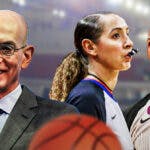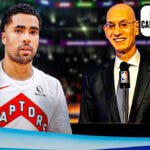NBA Commissioner Adam Silver and the league office have gone in an all-out effort to reform the NBA Draft Lottery in the coming years, hoping to de-incentivize tanking by lowering the odds of high lottery seeds.
In order to do so, the league would need three quarters of its teams to approve the reform in order for it to take place, totaling at least 23 of the 30 teams in place. If approved, this reform would start to kick in during the offseason of 2019, giving the league a year to prepare for the changes ahead.
“We are proposing that teams can no longer target finishing positions at the bottom, with a marginal difference in each seed from there on,” president of league operations Byron Spruell told ESPN's Adrian Wojnarowski. “We need to continue to focus on competitive play and owe it to our fans and business partners to do that. It's the right time to take action.”
Under this new reform, the team with the worst record to drop to as low as the fifth pick in the draft.
via Wojnarowski:
“The top three teams in the draft lottery's expected pick would drop from 2.6 percent to 3.7 percent, three percent to 3.9 percent and 3.4 percent to 4.1 percent, sources said.
The continuation of low odds on the back end of the lottery (Nos. 11 to 14) gives the NBA confidence that teams will not see a benefit to tanking out of the playoffs into the lottery. Under the proposed draft lottery changes, the last lottery team at No. 14 would keep the same two percent odds of rising into the top five of the draft.”
Silver tried to pass a similar reform in 2014, but fell short of the votes.
“Anytime you have taken odds away from the worst teams, you've redistributed them somewhere else,” NBA's senior vice president of basketball strategy and analytics Evan Wasch said. “But the odds are still low at the back end of the lottery. We don't fundamentally believe a team will want to tank out of the playoffs. That could be worth $5 million to $10 million in gates, plus a lot of (other) value to your franchise. Even if you tanked your way out of the playoffs to get to the 10th worst record, it's only slightly higher odds, a marginal change.
“We just don't see an owner and GM giving up and benefits that come with making the playoffs.”
Teams ranging from seventh to 10th would now have a stronger chance to move up into the top three picks, according to Wojnarowski — with No. 7's chances improving from 15 percent to 23, No. 8 from 10 percent to 19 percent, No. 9 from six percent to 15 percent and No. 10 from four percent to 10 percent.
This formula would allow for a wider range of teams to be able to improve their lottery stock, ones that continuously miss the playoffs but are stuck picking in the middle of the draft and not getting the talent needed to get ahead, despite trying to win all season long.
“Detroit spent six straight years in the draft lottery (2010 to 2015), but never selected higher than seventh,” wrote Wojnarowski. “They were active in free agency, had significant payrolls, but struggled to rebuild on the run. Detroit never bottomed out to get a top three pick, but those chances would improve now.”




